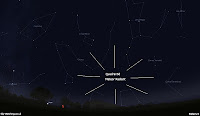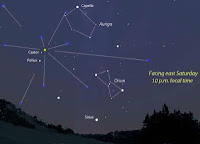The
Eta Aquarid Meteor Shower will peak before dawn on Thursday 5 and Friday 6
May 2016, with up to 45 meteors per hour at it's peak, radiating from
the constellation of Aquarius. This does not spend long above the
horizon in the Northern Hemisphere at this time of year, but is often a
good display in the Southern Hemisphere. The
Eta Aquarids are potentially visible between 19 April and 28 May, but
are extremely hard to spot away from the peak of activity, which this
year falls directly before the New Moon on Saturday 7 May, giving the possibility of some good viewing this year.
The radiant point for the Eta Aquarid meteors. Universe Today.
The
meteor shower is caused by the Earth passing through the trail of
Halley's Comet, where it encounters thousands of tiny dust particles
shed from the comet as its icy surface is melted (strictly sublimated)
by the heat of the Sun. Halley's Comet only visits the inner Solar
System every 75 years (most recently in 1986 and next in 2061), but the
trail of particles shed by it forms a constant flow, which the Earth
crosses twice each year; in May when it causes the Eta Aquarid Meteor
Shower and in October when it causes the Orionid Meteor Shower.
The orbit and current position of Halley's Comet. JPL Small Body Database Browser.
See also...
 Lyrid Meteors to be visible next week. The Lyrid Meteors will be visible between Saturday 16 and Monday 25
April 2006, with peak activity on Friday 22 April, when the number of
meteors may exceed 20 per hour. However with the Full Moon also falling
on...
Lyrid Meteors to be visible next week. The Lyrid Meteors will be visible between Saturday 16 and Monday 25
April 2006, with peak activity on Friday 22 April, when the number of
meteors may exceed 20 per hour. However with the Full Moon also falling
on... January's first meteor shower: The 2015 Quadrantids. The Quadrantid Meteor Shower is one of the brightest meteor showers of
the year, often producing over 100 meteors per hour at its peak, which
falls on the night...
January's first meteor shower: The 2015 Quadrantids. The Quadrantid Meteor Shower is one of the brightest meteor showers of
the year, often producing over 100 meteors per hour at its peak, which
falls on the night... Geminid Meteor Shower should be clearly visible this year. The Geminid Meteor Shower is expected to peak on Sunday 13-Monday 14
December this
year (2015) with potentially up to 120 meteors per hour being visible in
areas of the Northern Hemisphere with a clear sky...
Geminid Meteor Shower should be clearly visible this year. The Geminid Meteor Shower is expected to peak on Sunday 13-Monday 14
December this
year (2015) with potentially up to 120 meteors per hour being visible in
areas of the Northern Hemisphere with a clear sky...

